|
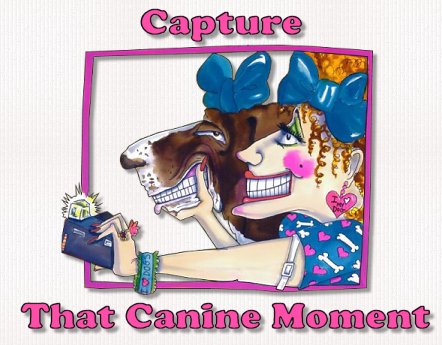

By Lynne McGuire
They give us unconditional love. They
make our lives richer.
It is hard to imagine what our life would be like
without them. Photography is a wonderful way to
capture forever the special moments that make up our
lives with our dogs. Photographs of their images become
our cherished keepsakes and record those moments in
time.
You do not need to be a
professional photographer and invest in expensive
equipment to take really good pictures of your dog. Understanding lighting, backgrounds, positioning,
and composition will give you the basic knowledge
to take better pictures.
To
help you capture your pet at his best, try these
techniques.
 |
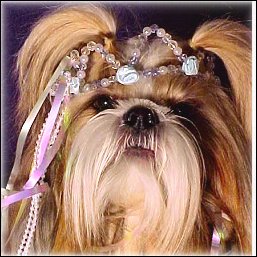
|
Planning Composition
Try to show your dog's true personality by
capturing their most characteristic
expressions and poses. No one knows your dog better than
you. What does your dog love to do? Let your composition
reflect what your dog loves to do.
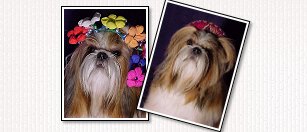
|
Composition
Try to take pictures during natural activities.
Be patient.
When you notice something that your pet does
that is a unique behavior that makes an
excellent photographic opportunity. This photo
of Sugar Bear smelling the flowers was somewhat
of a set up. I knew that one of her unique
behaviors was that she likes to eat flowers. I
have many pictures of her eating my potted
geraniums with flower petals all over her face.
So I was ready with the camera when I let her
outside in the backyard. She spotted the pink
Missouri primroses and went in for the smell!
|
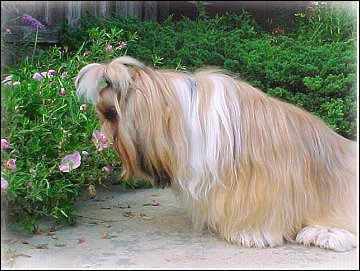
|
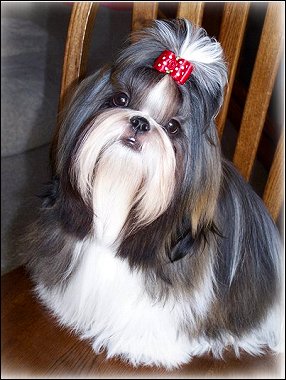
|
Composition~ Vertical
Pictures
Your pet photos will have more
impact when you work at improving the
photographic composition. Think outside the box.
Vary your picture taking to include
different perspectives. For example, try
turning your camera sideways and take some
vertical pictures. Let the subject matter
dictate the final shape of the photo. In
this picture, the chair back with its
vertical spindles dictate how to turn the
camera. All sorts of shots will look better
vertically. Notice that Roxy is
looking up slightly at the photographer.
This angle effectively mimics the vertical
elements of this photo.
Tip:
The noise from a empty
crunched up potato chip bag almost
guarantees that alert and appealing cocked
head look. Other effective noisemakers
include clickers and squeakers. Repetition
of a certain sound will use up its
effectiveness, so be prepared to change
tactics in a prolonged shooting
session.
|
Composition
Use
props for backgrounds that
create a mood or feeling to the
picture. My prop/background in
this photo is a vintage quilt
chosen for the soft colors to
complement the royal blue dog
bow.
When taking your dog pictures,
be sure and choose a background
that allows for adequate
contrast.
A 3/4 view of the body is
flattering for most dogs.
|
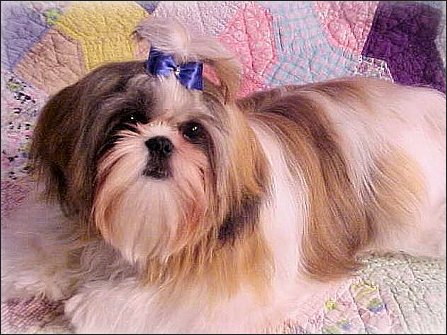
|
Backdrops and Backgrounds
for Setting Up Your Home
Studio
A variety of
materials can be used for
setting up backdrops and
backgrounds when planning a
photo session of your dog.
Experiment with old sheets
and blankets, even curtains
and lengths of fabric can be
used . The main idea when
choosing a background
material is to try to use
one with a pattern or tone
printed on it to create the
effect that you want. When
calculating how much fabric
you will need for a
backdrop, remember to allow
enough for behind the dog
and also to cover the floor.
For this photo my dog is
lying on a table that has
been covered with the quilt,
and the quilt is tacked to
the drywall behind him as a
backdrop. The dog should be
positioned fairly close to
the backdrop so that the
background receives enough
light.
|
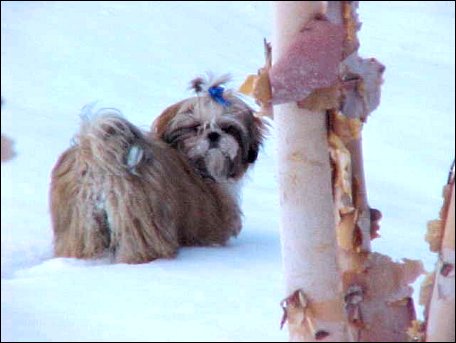
Your camera may try
to focus on the subject that is
centered in
the shot. To focus an
object that will be to the side of
the picture, center the object in
the picture, slightly depress your
shutter button 1/2 way down to lock
the focus. Next, reposition your
camera
while still holding the
shutter button so that the subject
is away
from the center. Press
the shutter button all the way down
to finish the picture.
|
Composition
No Need to
Center Your Subject.
The process of
arranging elements in a scene is
called composition. A
good photograph will have a clear
focal point or point of visual
interest. One way to create good
composition is to
avoid placing the focal point
(subject) in the center of the
picture.
Move your subject away from the
middle, off center, to create interest.
A compositional technique
called the rule of thirds can help
guide you in subject placement.
Imagine that the picture is divided
into equal thirds, both vertically
and horizontally. Place your focal
point (subject) away from the center
and near one of the quadrant intersections.
This makes your composition more
dynamic and interesting to the eye,
especially when framed or balanced
by the surroundings. Elements such
as this birch tree clump with
peeling bark in the next quadrant
adds a sense of distance and
dimension to the picture.
|

|
Composition
Create pictures with greater
impact.
Zoom in or
get close to
fill in the viewfinder or LCD display with your dog's face. That's the
best way to fill the frame
with the subject. Just like
people, pets have distinct
facial expressions that only
close-up dog pictures can
capture.
|
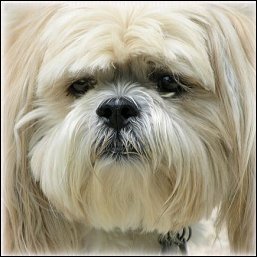
|
|
Think
of your photograph as
containing precious
space and don't waste
any of it on unimportant
or distracting elements.
If you fill the
viewfinder with only the
most important elements
before you shoot, your
photographs will have
more impact. There will
fewer distractions in
the scene to compete
with your subject Be
sure to read your
camera's manual to learn
the closest distance you
can shoot with your
camera to remain in
focus. |
Positioning...Posing Your Dog
You may want to pose your dog
instead of catching them in candid
shots. Some dogs are willing to sit,
stay, and pose. Others are not.
Bribery can work wonders! Figure out
what your dog loves to eat that is also
healthy for them, and use it to bait
your dog to pose. In this picture I am
baiting Sugar Bear to gaze downwards and
off to the side. I used a vintage quilt
as my background, because I wanted the
soft colors and soft texture behind her.
The light is to her right front as
indicated by the shadows on the backdrop
quilt. She is sitting fairly close to
the backdrop, and she is at a slight
angle to the camera. Even with her
sitting at an angle to my camera, I am
catching the telltale catch lights in
her pupils which tells me that my
lighting is correct. I try to keep this
sort of posed photography session very
short as the stand hot lights can
quickly make your dog uncomfortable, and
they will learn to hate having their
pictures made if the sessions are
stressful . Everything has been planned
in advance, the background, the props,
and the lighting. Know your dog and plan
your photographic sessions with
patience and empathy, and you will be
successful in creating keepsake images
of your pet.
|
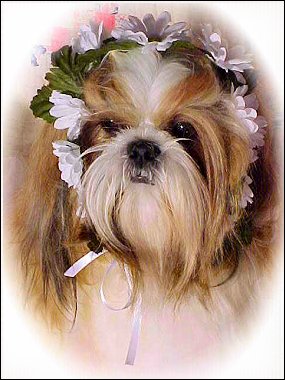
|
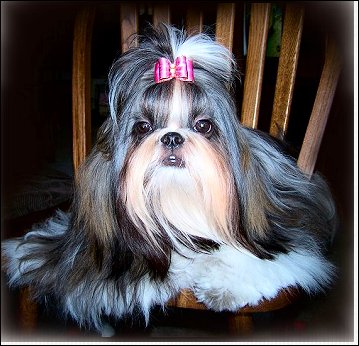
|
Positioning
Shooting at eye level...
Get down to your pet's eye
level and look your subject in the eye to create warm and endearing pictures.
You will get a more relaxed expression with your
pet looking directly at you. When using
furnishings to position your dog, try to zoom in
on the dog himself eliminating as much
extraneous background as possible.
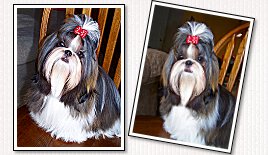
|
Outdoor
Lighting~Snow
Photography is all about the
light and recording light as images.
Photos are always
best when taken in natural light
outdoors. Overcast skylighton snow
appears rather blue but in this
photo adds to the effect. A bright
but overcast day is perfect lighting
for pet photography. Overcast
light produces no harsh
shadows and the color saturation (or
intensity) is increased, making the
colors in your photos look richer. Avoid high noon
sunlight on a clear day. It
generates a very hard light with
deep crisp shadows because it is
coming from directly overhead. Early
morning, late afternoon, or winter
lighting is best because the sun is
low in the sky.
Black Dog??? = Fill Flash
To take pictures of a dark or black
dog outdoors, try
using these
techniques. Position the dog so that
it is facing into the light. Try to
get the dog to lift its head
slightly, so that the eyes catch as
much light as possible. Use your flash
to soften shadows and brighten
colors. Because the flash is filling
in shadows and is augmenting the
light from the sun, this is known as
fill flash.
|

|

Photography by
Lisa Muraski of Mr
Foos Shih Tzu
|
Outdoor
Lighting Dappled Light
Dappled light is normally
created when the sunlight falls
through the foliage but is not
completely blocked. Shafts of
light reach the ground, and
you can position your dog so
that the light acts as a natural spotlight
illuminating your dog's face
creating a melody of shadows and
contrast.
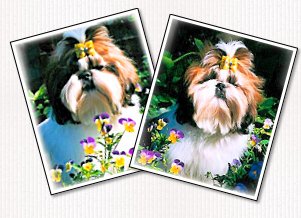
|
Inside
Lighting~ Side Lighting
Trash the
Auto-Flash
I
purchased a stand light on
eBay called a "Hot Light".
It came with a light
diffuser that attaches
directly to the light stand.
I usually position my hot light
to the left or the right of
my camera. It is set at a
height above the dog's eye
level to produce catch
lights in the dogs eyes.
Here I have my Shih Tzu
Sugar Bear
modeling a teal blue dog
bow. I have used a white
sheet hanging behind her to
create a uncluttered
background. My hot light
stand is to her left which
creates contrast on the
right side of her face. The
eyes should be the main
focus of the photo, and if
your lighting is well
planned, you will see
telltale catch lights in the
dog's eyes. Lighting your
dog from the side can really
emphasize the texture of
their coat and will produce
an image with a high degree
of contrast of shadow and
highlight areas. I like to
use this technique a lot as
I believe that the contrast
it creates adds interest and
dimension to the photo.
|
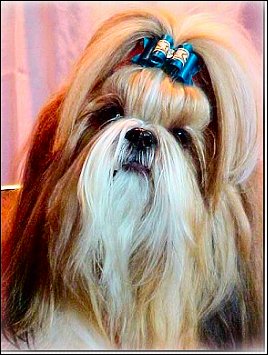
|
Red
Eye
Red-eye
phenomenon
occurs when a
cameras flash is fired
directly at the dog and
the light reflects off
the retina at the back
wall of the dog's eye
giving the eyes a red or
green glowing
appearance. Don't
use the flash on
your camera for inside
pictures or you will get
red eye and distortion
of the true colors and
shading of your dog. A
dog who's eyes have been
digitally corrected to
get rid of the red eye
effect, have lost the
natural catch light.
Artificial highlights to
the eye commonly
available in photo
software programs
produce a zombie type of
light dot to the eye. By using a
stand light to produce
your lighting, the room
is so brightened that
the dog's pupil will
constrict, and the light
cannot reflect to the
back of the dog's eye to
produce the dreaded red
eye effect. If you must
use a flash on your
camera, try to get your
dog to turn his head at
an angle to the camera
so that the flash does
not have a direct line
to the back of the eyes.
|

|
Window Light
Soft light from
a window can be a
perfect light for some
photograph effects.
With
plenty of natural light
coming from behind you
or from your side
face your pet to take
the photo. When
photographing your dog
using window light, make
sure that the light
falls on half to three
quarters of the dog's
face. Furnishings in
your home also make
ideal backgrounds and
add a personal touch to
your pictures. The window
light in this
photo is coming from a
large north-west patio
door in the late
afternoon. The first and
the last light of the
day that comes through
your windows is the best
light for shooting
photographs. Avoid
bright sunlight coming
through the window, as
in a south facing
window, as it mutes
colors, and creates
harsh shadows. An east
facing window in the
morning sunlight would
also be a excellent
choice of natural window
lighting. Avoid back
lighting where your pet
is in front of the
natural light because
the dog's face will be
shadowed deeply and will
become a silhouette. .
|
Take lots of pictures to get
that one great shot.
Devote
several photos to each
situation you shoot. Try
different angles, different
positions,
even different lighting. If the colors
in a scene are ho-hum, try
adding some props.
As a general rule,
the closer you get to the subject, the
better your pictures will be. It
eliminates distracting backgrounds and
shows the subject clearly. Think about
showing just enough of the background to
make the picture clear and interesting.
|
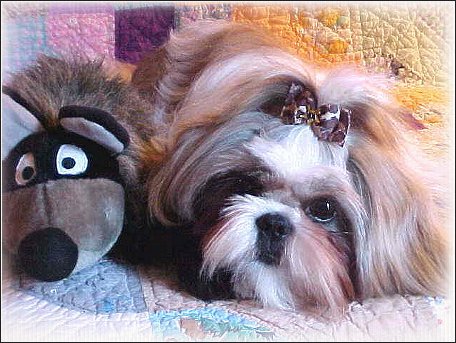
|
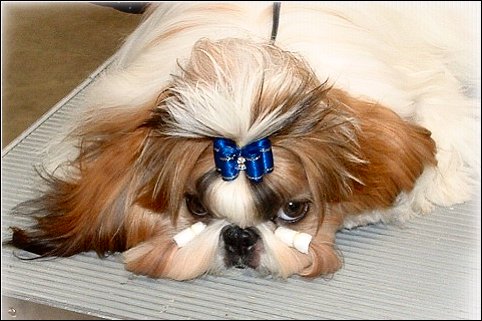
Photography by Lisa
Muraski of Mr Foos
Shih Tzu
|
Putting it all together.
This
spontaneous and candid
photo was
taken at a dog show and
epitomizes everything
that I love about
photography. Really, no
explanation of the photo
is necessary as the
image conveys the
personality and
circumstance of the dog
at the show.
Seek that perfect
expression on your dog's
face that captures his
unique personality.
Capture forever, the
special moments that
make up your life with
your dog.
|
More
articles by Doggie Bow Ties...
Check out my
dog bows! HERE
-->Home
Page


Doggie Bow TiesŪ Copyright 2018
Doggie Bow TiesŪ is a registered trademark.
This Web site is registered with theLibrary
of CongressCopyright Office.

Link to: http://www.doggiebowties.com

|